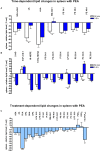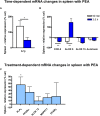Broad Lipidomic and Transcriptional Changes of Prophylactic PEA Administration in Adult Mice
- PMID: 31244590
- PMCID: PMC6580993
- DOI: 10.3389/fnins.2019.00527
Broad Lipidomic and Transcriptional Changes of Prophylactic PEA Administration in Adult Mice
Abstract
Beside diverse therapeutic properties of palmitoylethanolamide (PEA) including: neuroprotection, inflammation and pain alleviation, prophylactic effects have also been reported in animal models of infections, inflammation, and neurological diseases. The availability of PEA as (ultra)micronized nutraceutical formulations with reportedly no side effects, renders it accordingly an appealing candidate in human preventive care, such as in population at high risk of disease development or for healthy aging. PEA's mode of action is multi-facetted. Consensus exists that PEA's effects are primarily modulated by the peroxisome proliferator-activated receptor alpha (PPARα) and that PEA-activated PPARα has a pleiotropic effect on lipid metabolism, inflammation gene networks, and host defense mechanisms. Yet, an exhaustive view of how the prophylactic PEA administration changes the lipid signaling in brain and periphery, thereby eliciting a beneficial response to various negative stimuli remains still elusive. We therefore, undertook a broad lipidomic and transcriptomic study in brain and spleen of adult mice to unravel the positive molecular phenotype rendered by prophylactic PEA. We applied a tissue lipidomic and transcriptomic approach based on simultaneous extraction and subsequent targeted liquid chromatography-multiple reaction monitoring (LC-MRM) and mRNA analysis by qPCR, respectively. We targeted lipids of COX-, LOX- and CYP450 pathways, respectively, membrane phospholipids, lipid products of cPLA2, and free fatty acids, along with various genes involved in their biosynthesis and function. Additionally, plasma lipidomics was applied to reveal circulatory consequences and/or reflection of PEA's action. We found broad, distinct, and several previously unknown tissue transcriptional regulations of inflammatory pathways. In hippocampus also a PEA-induced transcriptional regulation of neuronal activity and excitability was evidenced. A massive downregulation of membrane lipid levels in the splenic tissue of the immune system with a consequent shift towards pro-resolving lipid environment was also detected. Plasma lipid pattern reflected to a large extent the hippocampal and splenic lipidome changes, highlighting the value of plasma lipidomics to monitor effects of nutraceutical PEA administration. Altogether, these findings contribute new insights into PEA's molecular mechanism and helps answering the questions, how PEA prepares the body for insults and what are the "good lipids" that underlie this action.
Keywords: PEA; PUFAs; endocannabinoids; inflammation; mRNA; phospholipids; targeted lipidomics.
Figures









Similar articles
-
Antiepileptogenic Effect of Subchronic Palmitoylethanolamide Treatment in a Mouse Model of Acute Epilepsy.Front Mol Neurosci. 2018 Mar 14;11:67. doi: 10.3389/fnmol.2018.00067. eCollection 2018. Front Mol Neurosci. 2018. PMID: 29593494 Free PMC article.
-
Palmitoylethanolamide modulates pentobarbital-evoked hypnotic effect in mice: involvement of allopregnanolone biosynthesis.Eur Neuropsychopharmacol. 2010 Mar;20(3):195-206. doi: 10.1016/j.euroneuro.2009.09.003. Epub 2009 Oct 27. Eur Neuropsychopharmacol. 2010. PMID: 19864116
-
Antiepileptic action of N-palmitoylethanolamine through CB1 and PPAR-α receptor activation in a genetic model of absence epilepsy.Neuropharmacology. 2013 Jun;69:115-26. doi: 10.1016/j.neuropharm.2012.11.017. Epub 2012 Dec 1. Neuropharmacology. 2013. PMID: 23206503
-
Is It Time to Test the Antiseizure Potential of Palmitoylethanolamide in Human Studies? A Systematic Review of Preclinical Evidence.Brain Sci. 2022 Jan 12;12(1):101. doi: 10.3390/brainsci12010101. Brain Sci. 2022. PMID: 35053844 Free PMC article. Review.
-
Therapeutic Potential of Palmitoylethanolamide in Gastrointestinal Disorders.Antioxidants (Basel). 2024 May 14;13(5):600. doi: 10.3390/antiox13050600. Antioxidants (Basel). 2024. PMID: 38790705 Free PMC article. Review.
Cited by
-
Chronic Pain in Dogs and Cats: Is There Place for Dietary Intervention with Micro-Palmitoylethanolamide?Animals (Basel). 2021 Mar 29;11(4):952. doi: 10.3390/ani11040952. Animals (Basel). 2021. PMID: 33805489 Free PMC article. Review.
-
Palmitoylethanolamide: A Nutritional Approach to Keep Neuroinflammation within Physiological Boundaries-A Systematic Review.Int J Mol Sci. 2020 Dec 15;21(24):9526. doi: 10.3390/ijms21249526. Int J Mol Sci. 2020. PMID: 33333772 Free PMC article.
-
Targeting sphingolipid metabolism with the sphingosine kinase inhibitor SKI-II overcomes hypoxia-induced chemotherapy resistance in glioblastoma cells: effects on cell death, self-renewal, and invasion.BMC Cancer. 2023 Aug 16;23(1):762. doi: 10.1186/s12885-023-11271-w. BMC Cancer. 2023. PMID: 37587449 Free PMC article.
-
A New Palmitoylethanolamide Form Combined with Antioxidant Molecules to Improve Its Effectivess on Neuronal Aging.Brain Sci. 2020 Jul 17;10(7):457. doi: 10.3390/brainsci10070457. Brain Sci. 2020. PMID: 32708932 Free PMC article.
-
Differences in Hypothalamic Lipid Profiles of Young and Aged Male Rats With Impaired and Unimpaired Spatial Cognitive Abilities and Memory.Front Aging Neurosci. 2020 Jul 3;12:204. doi: 10.3389/fnagi.2020.00204. eCollection 2020. Front Aging Neurosci. 2020. PMID: 32719597 Free PMC article.
References
-
- Artukoglu B. B., Beyer C., Zuloff-Shani A., Brener E., Bloch M. (2017). Efficacy of palmitoylethanolamide for pain: a meta-analysis. Pain Physician 20 353–362. - PubMed
LinkOut - more resources
Full Text Sources

